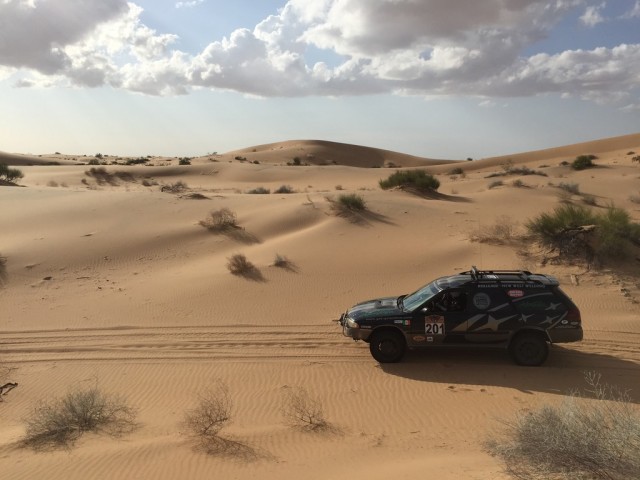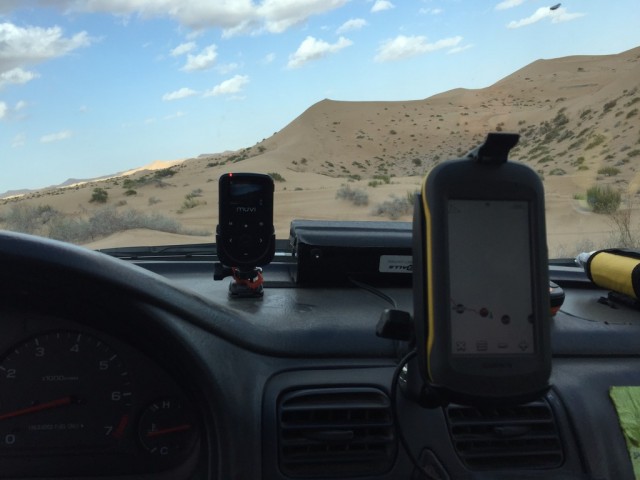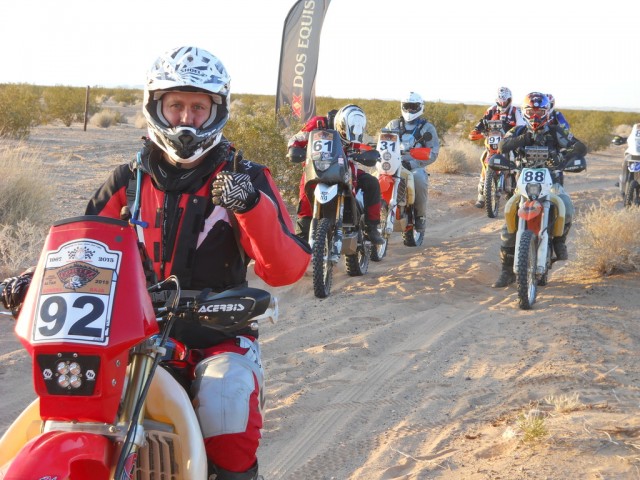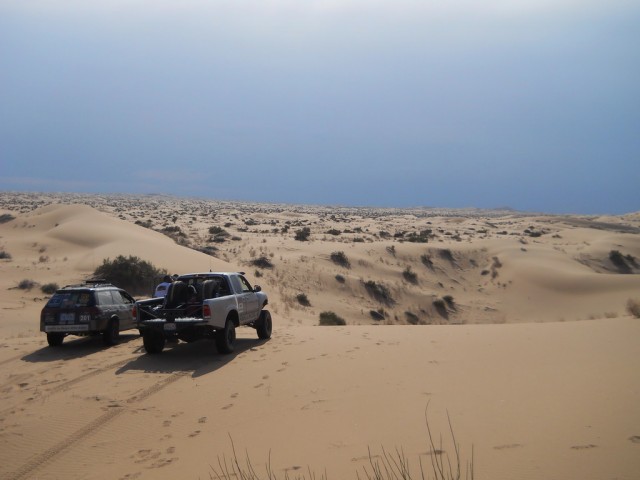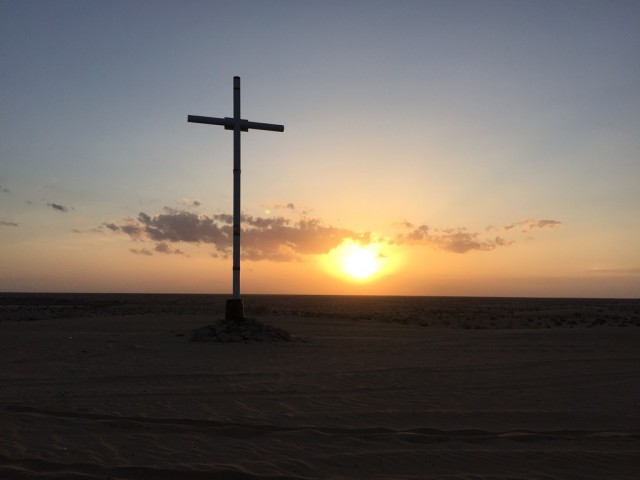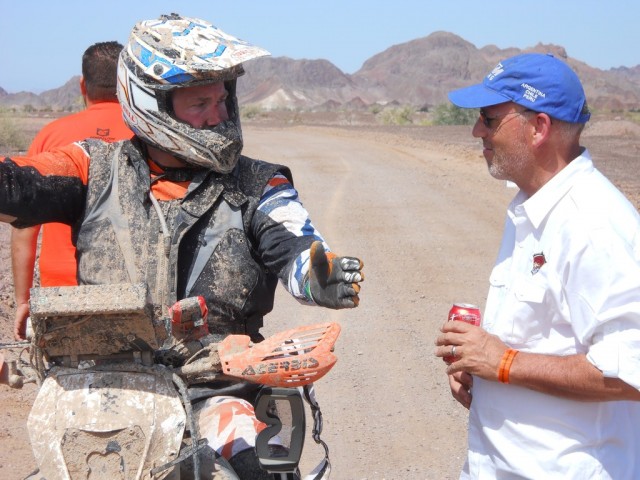We were somewhere around Mexicali, on the edge of a desert, when the scope of the navigational challenge began to take hold. We were cruising along nicely on a sandy two-track trail adjacent to the imposing, rusted-metal border fence – its vertical slats nearly mesmerizing me – when Laura’s voice over the intercom snapped me from my reverie, “We need to turn right.” “Where?” I asked. “Here!” she said.
There was nothing indicated where this turn should occur. There were no ribbons or arrows, no landmarks, and definitely no road or trail, just sand and brittle bushes as far as we could see. The road book’s little arrow (tulip) indicated it was nearly a 90-degree compass heading (CAP) change. Thus began the first hors piste (off road) section of the inaugural Cortez Rally and our first racing experience in a true rally raid event – which is a long distance, off road rally with added navigation challenges.
I can presume that if you’re reading Expedition Portal and Overland Journal, you have at least have heard of the Dakar Rally. But, just in case, the Dakar is considered by many to be the premiere rally raid event in the world. Originally staged in Africa and known as the Paris – Dakar, it is now run in South America where it is enjoying arguably more success and international recognition and is now simply known as, “The Dakar.” There have been few Americans to compete in the Dakar over the years and some blame it on the fact that there are few if any events in the United States, or even North America, in which prospective Dakar competitors can really hone their rally raid skills for the two- week-long Dakar. Enter the Cortez Rally, a race which hopes to fill that void.
The Cortez Rally is the brainchild of Dakar Rally veterans Scott Whitney and Darren Skilton. The backstory is that Scott was nuts enough to attempt the Dakar when it was still held in Africa on a Harley Davidson with a sidecar. Yes, you read that right.
Darren instead opted for the saner choice of four-wheeled vehicles and was able to podium first in class twice in the South American Dakar. Since then, both men have dreamed of bringing a true rally raid event to North America. With the 2015 Cortez Rally held in Northern Baja and Sonora Mexico, that dream came to fruition.
Unlike most other popular off-road desert races in North America, rally raid is unique in that it offers serious navigational challenges, along with the expected driving difficulties. Typical modern desert races employ course markers, maps, occasional road books, GPS tracks and pre-running – or any combination of those five things. In rally raid, you are given a road book or roll chart and are expected to “hit” hidden waypoints (WPM) in order to avoid penalties. Heck, in the Cortez, they didn’t even tell you the specific geographic area you would be racing the first 2 (of 3) days, just that it was somewhere in the Sonoran Desert. Cortez racers, whether on motorcycles or in 4-wheeled vehicles, would use a road book or roll chart in collaboration with an adjustable odometer and a compass. In order to keep costs down, Cortez organizers also let racers also used specially prepared consumer GPS units which were programmed to show the hidden waypoints that needed to be “hit” – but only when you were within about 200 meters of their location.
We had decided to enter the Cortez with our 1997 Subaru rally car and began practicing at our local OHV recreation area. We thought we were kings climbing out of the bowls and racing across the Oregon dunes. Of course, the joke was on us, because the dunes of the Cortez Rally made the Oregon dunes look like speed bumps. Luckily, I have had some experience driving in sand and our old lifted Outback, “Dirty Dorothy,” is actually quite capable in the soft stuff.
When I took that first hard right “hors piste” into the sand and pucker-brush, Laura, my wife and navigator, took very-real control of our destiny. Laura had to trust the road book in her hands and the odometer reading and CAP heading of the ICO rally computer we had mounted on the dash. And I had to trust her.
During the first few miles of the rally, Laura had been diligently adjusting the odometer up and down as needed to keep it calibrated to the road book whenever we passed a marked waypoint or landmark. As the old Subaru jerked and bounced off the trail and into open desert, I was repeating in my head what Scott Whitney had said at the driver’s meeting the night before: “Trust your road book, your odometer and your heading.” Oh, and in my case, trust your wife. It turned out, although a talented medical professional, Laura might have missed her calling as a professional rally navigator – because she did an amazing job of keeping us on “course” for the entire event.
The inaugural Cortez Rally attracted 18 vehicle entrants hoping to get their own taste of Dakar – 14 motorcycles, 1 UTV and 3 Cars. The beauty of the course and terrain cannot be overstated. This was not your typical whooped-out Baja desert race. Scott and Darrin lead competitors through pristine sand dunes and roads that were not yet torn up by 1200 horsepower trophy trucks. As is the case in most rally raids, the motorcycles ruled the roost. Dakar veteran and Baja Champion Quinn Cody lead the pack of bikes through the dunes with Scott Bright following close behind over the tops of dunes that would have stopped any four-wheeled vehicles stupid enough to follow.
Perhaps the most interesting (if not the craziest) of the entrants, was Jason Adams, from upstate New York. Adams decided it was a great idea to assault the Sonoran dunes (some hundreds of feet tall) on a 1974 BWM R100. Despite several mechanical difficulties, Adams took advantage of the multi-stage, multi-day rally format to repair his motorcycle and stay in the race. Unlike Dakar where failure to finish a stage ends in a disqualification (DQ) of the entire event, in the Cortez Rally, participants can miss or fail to finish a stage and take a serious time penalty, but still compete if they are able to make the necessary repairs to start the next stage.
On day two, we came across Jason along the course dealing with a disintegrated rear bib mousse and gave him some huge zip ties as he was zip tying his tire to his wheel. He was forced to return to the bivouac to fix the bike. On day 3, we found Jason again, this time alongside the road during a transit stage with his driveshaft in his hand. He was pacing around mumbling like a madman “where’s my truck, I just need my truck, I have spare bolts in my truck.” We were able to confirm for him via radio that his chase truck was still behind him and would be passing by soon. We left not knowing if we would see him again that day. True to form, he was able to get the bike going and went on to finish the rally in Ensenada before us, illustrating what true rally raid spirit is all about – never giving up!
Unlike a point-to-point desert race, or even a rally like the Dakar, which has bivouacs that follow the course of the rally, for the Cortez Rally, there was one established bivouac from where the stages for the 2nd and 3rd days started. This fact made it much easier logistically for a grassroots team such as ours. Unlike previous Mexican races where we needed to coordinate a chase team to follow us along the route and/or meet us at road crossings for fuel or repairs, having a set bivouac means the chase crew is stationary and waiting to make repairs and help recoup following the day of racing. This proved to save us lots of money and additional headaches.
It also proved helpful after picking up the only two nails in the entire Sonoran desert, thus requiring the crew to locate two new tires. Having the bivouac a few miles from San Luis Colorado (and 15 miles from Yuma, Arizona) meant that parts would not be hard to find. After plugging our two tires, we finished the day and found two fresh BFG KO2’s waiting at our camp.
The Cortez Rally crew also did an amazing job of making the bivouac feel like home by converting an old brick farm building into an oasis for tired and hungry (and thirsty) racers. We were fed delicious homemade food by a local off-road racing club who donated all proceeds to their local volunteer fire-rescue department. In the evenings, the smell of grilling carne asada filled the bivouac as racers reviewed and prepared their road books for the next day in what was a true relaxed familial atmosphere.
The final day of the Cortez Rally led racers through more traditional Baja terrain as the route followed parts of the previous Baja 1000 course and made its way to the finish line in Ensenada. Our two fellow car competitors, a V8 Chaparrel buggy (which we had pulled out of a sand trap) and a vintage trophy truck, both retired from the race with transmission problems before day 3. This made our production class Subaru the only car left in the rally. This also meant we now just needed to finish for the overall win. We opted to take penalty points rather than risk taking our tired, 4000-pound, 170 horsepower car with a fried clutch onto the flooded Laguna Salada lakebed, which according to those that made it through, would have ended our day (and race) for sure. To quote Dirty Harry, “Sometimes a man’s got to know his limitations.” Luckily, I do. The lone UTV team kept fighting gremlins along the way, but never gave up. I admit, I secretly covet the ease at which those UTV’s can be turned into world-class race vehicles, perhaps someday I’ll have to give them a try.
We rolled across the finish line at the Horsepower Ranch just outside of Ensenada with 11 of the 18 competitors that had started in Mexicali. There was a large crowd gathered at the ranch but none seemed terribly interested in the activities near the finish line. Turns out, the registration for the Mexican 1000 rally (which the Cortez is affiliated) was also taking place and most of the hubbub at the ranch was surrounding the display of vintage race cars and teams trying to get their paperwork in order for their race, which was to start the next day.
This muted response to the finish of the Cortez Rally happening right in front of them seems to echo the sentiment expressed by most traditional Baja racers toward the concept of rally raid, and one that Scott Whitney and Darren Skilton hope they can change. “It seems everyone who tries it loves the challenges, and rally format opens up new possibilities for course routing while minimizing the impacts to the environment,” said Whitney.
Both Whitney and Skilton believe that the way to grow rally raid here is to continue creating a fun and challenging event that will get people interested in giving it a try. “No one has attempted to put on a rally in this type of terrain before and everyone was blown away when they ran the stages. As long as I have 20-30 people who want to do a rally, I will try to put it on,” said Skilton.
After competing in the first-ever North American rally raid, we have come away with a greater understanding about why the rest of the world is nuts for these type of events. Those who like to build off-road expedition vehicles, compete in time-speed-distance and stage rallies, and enjoy orienteering and the like – might be a demographic more in line with the sense of driving adventure, navigational challenge and mechanical knowhow that rally raid encompasses over traditional closed course or point-to-point desert racing.
“We have discussed adding a non competitive “Raid” class to allow people to enjoy some of the adventure without the need for competitive race vehicles. But it does impact logistics by adding people. It has to make sense. I am thinking we will limit the entry to 50 vehicles (bikes and cars) so we can maintain quality,” said Darren Skilton.
“We’re looking at a number of ways to expand the rally, including trying to attract those more oriented towards adventure than pure speed racing,” added Scott Whitney.
There are solid plans for the 2016 Cortez Rally, and they promise it will be better than the first. We will be there again with our venerable Subie and would love to see some more four-wheel participants the next time around. So, that gives everyone about 9 months to get a roll-cage, race seats, harnesses and window nets in their overland vehicles and meet us in Mexico for an adventure of a lifetime!
About the author – Paul Fournier has a bad case of ADD, an addiction to adrenaline and an affinity for writing about food, adventure, travel and real-life characters. His home base is a small beach cabin on the Oregon Coast, which he shares with a supportive wife and two not-so-bright canine companions.



